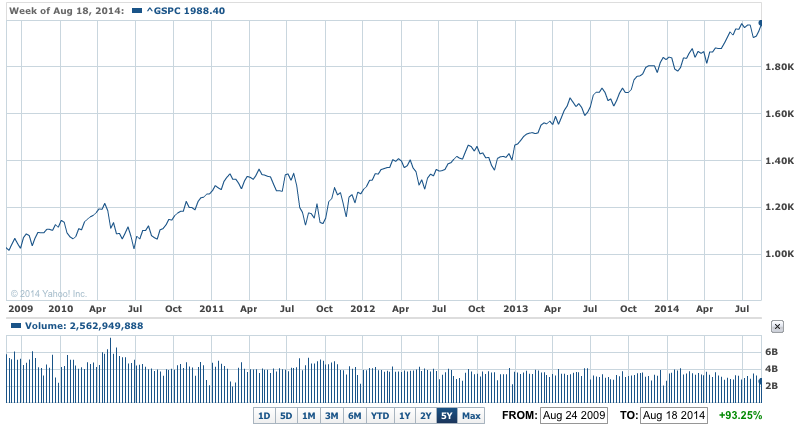So will the S&P 500, the key global index of stockmarket confidence, hit the 2,000 point mark for the first time this week after going close last week?
US markets have been edging higher in the past two weeks or so, with the S&P going close to the all time high on Thursday and Friday, but not breaching the 2,000 point level.
As a result the S&P 500 is around 12 points, or 0.4% shy of that level after Friday’s close at 1,988.40. That was down 3.97 points, or 0.2% on the day.
The Dow shed 38.27 points, or 0.2%, to end at 17,001.22, but the Nasdaq Composite added 6.45 points, or 0.1%, to close at 4,538.55.
The three main indexes all achieved their third weekly gain in a row. The S&P 500 and Nasdaq both advanced by 1.7% for the week, while the Dow rose 2%.
The markets had the wind taken from their sales (temporarily) on Friday by Fed chair, Janet Yellen who signalled that a possible rate rise might be closer than previously thought, and the Russian ‘aid’ convoy which moved into Ukraine.
But by the weekend the markets had concluded Ms Yellen didn’t really say anything dramatically new for the markets, and the Russian convoy drove back out of Ukraine, leaving the way for the markets to move higher this week.
US analysts say that if the S&P 500 does hit the 2,000 point mark soon, it will be ahead of most forecasts which tipped that to happen around the end of this year.
The S&P index is up nearly 8% so far in 2014, and 12.7% in the year to last week, outperforming most major overseas indexes and overcoming the weather-depressed first quarter and political unrest abroad in Iraq and Ukraine and a tech sell off from February to May.
According to Reuters and Bloomberg data every S&P sector is positive year-to-date, with tech and healthcare both up about 13%, and the defensive utilities group is up 11%.
The big question now for markets is the way they react to the Fed ending its easing program in October, which is the month of choice for investors to lose it and sell off (October 1929, 1987 and 2008, where the slide started in September when Lehman Brothers collapsed).
S&P 500 5Y – Watch for 2000 on S&P 500

Apart from the solid rise in US shares, Eurozone shares gained 2.3%, Japanese shares rose 1.4%, Chinese shares rose 0.6% and Australian shares improved 1.4% thanks to the better than expected June 30 reports.
Commodity prices were mixed though, with oil and gold down but metals up.
A stronger $US saw the Yen and euro down, but the Aussie dollar was little changed at just under 93 US cents.
Our market will start with a small loss of 10 points or so according to the futures market’s close early Saturday morning.
The ASX 200 Index added 1.4% last week to 5645.6 points, while the All Ordinaries Index was up 1.5% to 5640.5 points.
In commodities, gold and oil both had poor weeks.
West Texas light, sweet crude futures for delivery in October slipped 31 cents, or 0.3%, to $US93.65 a barrel on the New York Mercantile Exchange. New York-traded oil declined 1.8% over the five-day period, its fourth straight weekly loss.
October Brent crude on London’s ICE Futures exchange fell 34 cents, or 0.3%, to $US102.29 a barrel.
Brent declined 1.2% on the week, its second consecutive weekly loss.
Comex gold futures for December delivery rose $US4.80 on Friday to settle at $US1,280.20 an ounce in New York.
That left it down 2% for the week.
Copper had its best week for a month, ending up 3.2% on Comex at $US3.223 a pound (returning the price of the metal to where it was in early August).
In London the price traded over 7,000 pounds a tonne with and closed at 7,076 pounds a tonne or $US3.21 a pound.













